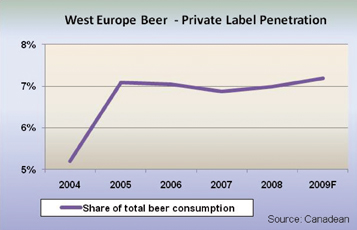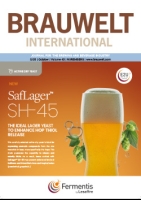Asahi said its domestic beer sales during 2009 came to 177.0 million cases, down 2.5 percent year-on-year, while Kirin’s annual beer sales amounted to 176.8 million cases, down 1.9 percent. One case is equivalent to 12.66 litres of beer.
Global functional drink sales increased by 3 percent in 2008 to 26.5 billion litres, 8 billion litres more than in 2003, according to the latest report from food and drink consultancy Zenith International. Average growth over the past five years has been 8 percent a year.
Private label beers are gaining share on their branded rivals in 2009 as the recessionary conditions have made them more appropriate to consumers across the region. A new report on private label beers in Europe from specialist beverage research agency Canadean suggests however that although share may be rising, volumes are not. Share is growing because private label products are falling at a slower rate than branded products.
Modern brain research shows: emotions are the real and powerful decision-makers in the human brain. Furthermore: 70 to 80 percent of all buying decisions are made unconsciously. How can these findings be used in beer marketing? Gruppe Nymphenburg Consult AG has developed an instrument, Limbic®, in order to ensure that brands have a seat in the front row in the mind of consumers.
The global beer market continues to grow despite the dramatic upheaval in the world’s financial markets in 2008. The economic woes have however impacted beer volumes and according to Canadean, the leading beverage research agency, growth in the global beer market dropped from a respectable 6 percent in 2007 to less than 2 percent in 2008. Canadean’s recently published Global Beer Trends Report anticipates a further slowdown in 2009 before demand begins to accelerate again in 2010.
In the third quarter of 2009, Symrise AG improved its sales and earnings despite continued economic challenges. In a weak overall market, the Group increased third-quarter sales over the same period of 2008 by 5.6 percent at local currency, and by 4 percent on a pro forma basis. Both business divisions and all regions contributed to the growth. The EBITDA rose by 12 percent at local currency in the third quarter, benefiting decisively from the improved sales performance as well as from the first savings effects from the restructuring measures implemented in the first half of the year. In the first nine months of the year, the Group achieved an EBITDA margin, adjusted for restructuring expenses, of 19.7 percent.
Breweries provide themselves almost exclusively with fossil energy. Kaspar Schulz KG, Bamberg, has developed a concept for providing CO2-neutral energy to breweries to protect the environment and reduce the cost of energy by eliminating the continued reduction of our natural resources.
The struggle between brewers for mastery of the world’s markets over the past twenty years has everything: two mighty foes, AB-InBev and SABMiller, convinced of their own destiny; two boisterous also-rans, Heineken and Carlsberg, who thought they could keep up, but failed; a cast of larger-than-life Brazilian investors, vituperative Mexican families, Belgian nobles, and obdurate American CEOs, whom the media dubbed “the kings of beer”; and one astonishing set-piece battle, the takeover of Anheuser-Busch, that witnessed the sort of savagery and sheer bloody-minded audacity that make one’s hair stand on end.
The Kyoto protocol from 1997 which entered into force in February 2005 was followed by the 6th Environment Action Programme, the European Commission’s environment priorities for 2002 to 2012. On 9 December 2008 the EU Parliament delegation, the EU Council and the European Commission agreed on the EU Directive on Renewable Energy. The directive sets ambitious standards to put renewable energy at top of energy mixes. One of the goals is to increase the market share of renewable energy from around 8.5 percent today to 20 percent by 2020 by means of binding national targets. That raises the question what can be done in practice to achieve those objectives.





